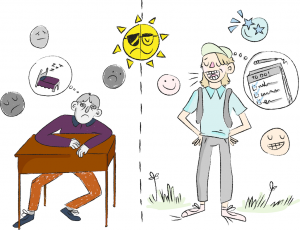Daylight Saving Time Saves No Student From Sleep-Deprivation
March 9, 2020
Daylight Saving Time, a practice started during World War I to minimize artificial lighting use, has become an outdated system that burdens more than it benefits. Despite positive claims that it increases productivity, DST has become an issue, depriving sleep from already exhausted students, causing health issues and saving no energy.
With overwhelming assignments, tests and projects, many students often work into their sleeping time. However, even more of their sleeping time is reduced when DST disrupts their natural sleeping cycle.
According to a study conducted by Michigan State University, individuals tend to sleep less during the week of the time change, because the body experiences symptoms resembling jet lag.
“People tend to sleep 40 min less following phase advances as compared with all other non phase change days,” Michigan State University wrote. “Our data indicate that people tend to utilize the extra hour in phase delays for waking activity rather than for sleep.”
Lack of sleep also contributes to health issues, especially if the body’s natural sleeping cycle is disturbed twice a year.
In a Daily New York Times article, Dr. Shelby Harris, director of Behavioral Sleep Medicine Program, acknowledges that changing of the body’s clock just by an hour can throw off hormones and cause “cluster headaches,” the “sudden, severe, headaches” described by the National Institutes of Health as “one of the most painful conditions known to man.”
As sleep deprivation can affect daily behavior for several weeks, this change can also decrease productivity, contradicting the commonly believed claim that DST increases productivity from longer exposure to daylight.
“The consequence of [DST] is that the majority of the population has drastically decreased productivity, decreased quality of life, increasing susceptibility to illness, and is just plain tired,” German chronobiologist Dr. Till Roenneberg said in an interview with National Geographic.
Health issues are not the only problems caused by DST. Contrary to the initial purpose to save energy in the early 1900s, DST now serves as an ineffective energy-conservation solution due to how the system stimulates greater heating costs in the mornings and increased use of air-conditioners from hot afternoons.
According to a study from University of California, Santa Barbara, professor Matthew Kotchen and PhD student Laura E. Grant states DST increases residential electricity demand because “in hot periods daylight saving time means air conditioners tend to be run more when people arrive home from work, while in cooler periods more heating is used.” This was not an issue during the first implication of the system because not as many people used air conditioning devices.
DST defeats the original purpose and has become a burden fatiguing students with health problems and productivity issues. CA voters have already approved of eliminating DST in 2019, but the idea still requires a two-thirds majority vote from the state legislature and then an approval from congress. Although it may be difficult to eliminate the long-standing regulation, there must be serious consideration put in by the California state legislature and congress in order to get rid of the ineffective law.
Students can email district representatives and senators to push for a change. Examples would include senator John Moorlach, representative of parts of Orange County in the California State Senate, as well as Steven Choi, Irvine’s representative for the state house. The steps students can take to eliminate DST may be small, but persistence over time can play a role in removing this cumbersome procedure.



